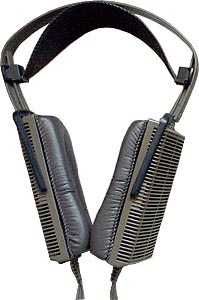|
 |
|
 |
|
|
 |
The only visual distinction between the Classic and Signature 'phones? The former's case work is olive with grey pads and olive umbilical [left]. The latter uses brown with dark brown pads and a brown ribbon umbilical [right]. Said 8' foot cable is equally long but double the width of the Classic's. Spring-loaded by the plastic bridge, these very comfortable, 472-gram light earspeakers apply just enough pressure to effectively seal the area around your ears. With the low 90s of Arroyo Seco's high desert in July, the resultant chambers of trapped air warmed up quickly to cause a minor case of sweaty ears on hot days.
The hard plastic used for the structural elements made little crinkle noises when moving head or jaw. Image 3 shows one speaker module flipped 180° around its swivel mount to display the inside of the ear pads. The translucent diaphragm is protected by metal mesh and thin foam and, on the outer edges, shows two reddish stator ovals separated my a solid metal spacer about 1/4" thick. I heard no discharge crackling or any other audible reminders that a high-voltage charge remained applied to the diaphragms whenever the driver amps were powered up and connected. Image 4 shows the perforated casings from the underside. This displays how the sealed diaphragm naturally splays away from the ear to follow the organ's natural outward angle in an averaged parallel. Fit'n'finish? First-class. There were no visible fasteners to give away how these marvels were assembled. Though my mind knew better of course, inspection could fool one into thinking that these earspeakers and their cables were molded from a single piece. "Fascinating", as pointy-eared Spock would dryly comment. |
|
 |
|
 |
|
|
|
|
 |
|
 |
|
 |
|
 |
|
Time to render judgment. But where to begin? With some levity. As my Cabalistic guru likes to point out, the journey of ten-thousand miles begins with a single oy. Thus wherever you go, there you are. But your treasured luggage's a different story altogether. Another oy. Remember then to calmly breathe in and out, in and out. Should you forget that, you'll have far more serious problems at hand than attaining enlightenment. Oy weh for real now. Pour yerself a cuppa tea instead to nourish your skittish life force. With the first sip, joy. With the second, satisfaction. With the third, Danish. Presto. Properly prepped to be here now and elsewhere later, I began with both the Classic and Signature jacked into the PRO ONLY sockets of the 006t. After all, if you wish to know The Way, don't ask for directions - argue. And did I ever argue, with myself and over the discernable differences between these two.
|
|
|
|
| Take the witty, very well-recorded Tell Mambo by audio fonctionnaire Oscar Hammel [Tinder 42859592], a remarkable solo continuation of his sensational work with French salsa formation 'Fatal Mambo'. About a Mandingo lady in his "Enamoure" adaptation of "Bilongo", he sings "bella créature mon ami m'a rendu loco, bella créature ensorcelie m'a fait bilongo". And indeed, listening over these two electrostatic earspeakers was a very bewitching experience. It would also drive me loco to discern differences. The foremost qualitative impression of the STAX sound per se? One of extreme facility and effortlessness - as though the air moved by itself without any material intermediary. "There's nothing there making sound" was the instinctive assessment of my subconscious neuro mechanism. To avoid manufactured transference -- after all, I knew how the principle involved made for an indescribably thin membrane virtually as light as air itself -- I switched to my K-1000s to sample their way of going about the same business. |
|
|
|
 |
|
|
Sure enough. The AKG's tactile sensation translated as muscular, athletic, pumped up and charged. I'm not talking frequency response or quantitative aspects but sonic gestalt. Imagery that came up thinking about how the ring magnets of the K-1000's dynamic drivers propelled sounds forward? I netted batting practice - pressure fluctuations in the air generated from a machine that spit out notes like balls exploding full force toward a swinging bat. By contrast, notes by STAX felt like light reflecting off rippling water - what a famous Zen koan calls "Sitting silently doing nothing, spring comes and the grass grows by itself". Naturally, my Jewish savant swami would instantly question who'd mow said lawn.
This effortless electrostatic action made for stunning transparency deep into the musical fabric. This remained true even at very subdued levels where the AKGs collapsed to give up and sound asleep, their ability to accelerate and exhibit their famed precision clearly happier at a higher plateau of the output power band. While the K-phones could downscale volume only so much before suffering data dropout --sensing that you were no longer hearing all you should -- the electrostats hung together far longer, down into supremely relaxed background listening levels. This would make them ideal for folks who customarily enjoy very modest levels but still insist on getting the full undiluted dose of the musical message. In movie terms, the curtain of the STAX 'phones plainly lifted very early while the competition still sold tickets and piped elevator music to the already-waiting patrons. Because of their push/pull open-backed nature, these earspeakers cause modest sound leakage into the room. Ditto for the AKGs.
This made for an interesting comparison. By alternately switching to unused inputs to mute the 006t and Unico respectively, I could audition the phones on the floor without actually wearing 'em. Venting into plain air without the boundaries and reflections from a skull, the AKG's had distinctly more treble energy, sounding bright and peaky in the upper midrange. The STAX 'phones enjoyed a warm mid-range centered tonal balance in the same scenario, suffering some expected roll-off in the frequency extremes. Back on my head, the SR-303 proved a virtual clone of the SR-404 not just in the looks, size and constructional details department. The only useful aural differentiator I thought I could eventually pin down? A very fine softening of leading edges. It made the Classic sound a smidgen warmer than the Signature - not quite as precise. Perhaps.
You know how certain speaker companies advertise the second or third model from the top down as having the same sound as the champ, just scaled down - or the same sound, but optimized instead for smaller spaces? With these STAX phones, there was no reduction, dilution, down-scaling or "the same but simply less of it" math. Sporting the same new ultra-thin diaphragm of undisclosed composition, the only published difference in specs I could find? 10pF lower cable capacitance with the 404. That's pico farads as in tiny. One assumes that there must be further differences to justify the price difference (of which I deliberately remained unappraised until later in the review). Heightened conductor purity? Material refinements in the charging structure? Who knows. Regardless, lengthy listening netted no reliably discernable differences with this recording, certainly none in frequency response, tonal balance or overall presentation. The sharp Cuban trumpets of Philippe Anicaux and Alain Henriot were the only areas where the aforementioned subtle softening of the SR-303s seemed to come to the fore - as though a few more hairs of copper had crept into a mixed copper/silver cable like an Acoustic Zen. Perhaps.
|
|
|
The ambient/trance album Vivid by Najma Akhtar, rightfully dubbed Indian Gothic [Mondo Melodia 186 850 075-2] for its moody, dark soundscapes -- befitting a brooding Caped Crusader in his BatCave had his movies been filmed in Bolly- rather than Hollywood -- showed no advances in synth bass reach, weight or impact using the Signatures, no further body on Najma's serpentine vocals. Only in the electric sarangi, an Indian bowed cello, could one again imagine to spot the 303's ever-so-faint damper on transient bite. Was I to pronounce the Classic a marketing mistake - far too close in performance to the Signature to successfully sell the latter; way too much applied trickle-down technology to flush the foundation of superiority out from under the 404 with a Biblical vengeance? I needed audiophile-approved high-resolution tracks to be extra sure.
|
|
 |
|
| In went the Underwood Hifi Level-2 modified Shanling T-200 SACD/CD player and Mark Levin- son's Red Rose Music - Live Recordings At, Volume 1 [RRM 01] with SACD and CD layers engaged alternately. If this was gonna be a matter of software quality, now I was surely in serious company. Indeed. While Adele V. Anthony's spiccato passages of Kreisler's Scherzo on her Guarneri del Jesu instrument showed off the same earlier leading edge differences for certain now, I could hear further changes. Chico Freeman's tenor sounded a bit more immediate, as though somewhat closer and thus slightly fuller. Simon Mulligan's Förster Grand's startling harmonic density exhibited even more sparkle on the Signature, as though the temporal fireflies of overtones flew higher and lasted just a fraction longer before extinguishing. Bill Sims'' vocals -- "...make a bulldog of a hound..." -- acquired a modicum of added heft when switching to the 404s; no outright bulldog transformation but a day's worth of extra portions for temp girth. |
|
|
|
 |
|
|
|
Depending on track, returning to the 303s and during the first split second of acclimation only, it now always seemed as though I incurred the most transparent of filters. Think clear foil over glass. It doesn't darken or distort anything. It simply grows the barrier which the light has to pass to reach your eyes that tiny bit thicker and hence less direct. Returning to the CD layer of this hybrid disc wiped out these differences to merely imaginary. |
|
 |
|
In short, the 404s were a skoch more transparent. Alas, it took SACD vs CD therapy to become an issue that was even detectable. As any honorable shrink would tell you, if you have to work that hard to have problems, you might as well not bother to get better. Save yourself the expense of the sessions. Or, dispatch your little sister instead. Clearly, the Classic cashes the same aural checks, by cloning its brother's John Hancock like a master forger. This flimflam's verifiable only by a truly anal SEC expert. Time to call Tats and get the pricing scoop.
The Signature and Classic systems sell for $2,365 and $1,425 respectively. Broken down into individual constituents, higher per-unit pricing kicks in to make the 404 and 303 earspeakers $915 and $690 while the drivers -- tube and solid-state -- become $1,805 and $915. That's a $355/190 discount if you purchase the Signature/Classic components together at one time. You cannot cost-effectively mate the 303 with the 066t as your friendly audio broker would otherwise have suggested. That combo would set you back $2,495, $130 more than the packaged 404/066t rig. STAX must have targeted a particular price for the Classic system and subsequently found a way to shave off expense by going to the half-width cable. (Incidentally, parts & labor warranty is 1 year. Yamanashi-San volunteered that first service will be due anywhere between 10-15 years from point of purchase. How does he figure that? Yama's Inc. performs all US-based STAX service calls. From working on the older models with the 230V bias charge, he knows the time frame for the first tune-up interval from extensive experience.) Now that the earspeaker models had been compared side-by-side, I'd look into the electronics, then compare XLR and RCA feeds on the 006t and do a baseline comparo against the AKG K-1000s (SOTA dynamic vs SOTA electrostatic designs).
|
|
|
|
 |
 |
|
|
|
 |
|
|
|
|
|
|
|
|
|
|
|
|
|
|
|
|
|
|
|
|